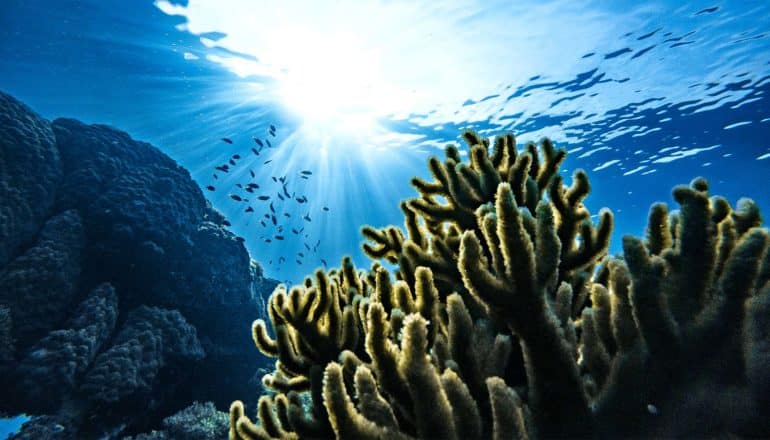
(Credit: Marek Okon/Unsplash )
Ocean’s CO2 absorbing powers change over time
The ocean is one of the biggest absorbers of carbon dioxide, but that absorption isn't always steady.

New research digs into how the ocean’s processes for absorbing carbon change over time, and how they might affect its ability to buffer climate change
For Timothy DeVries, an oceanographer at the University of California, Santa Barbara, and graduate student Michael Nowicki, gaining a good understanding of the trends in the ocean’s carbon cycle is key to improving current models of carbon uptake by the Earth’s oceans. This information could, in turn, yield better climate predictions.
“…the rate at which CO2 was accumulating in the atmosphere doesn’t necessarily track emissions.”
“We started off looking at the rate at which CO2 was accumulating in the atmosphere, and then we compared that to the rate of emissions,” DeVries says. “One would expect basically that if you’re increasing emissions at 10 percent, the accumulation rate in the atmosphere should increase at 10 percent, for example.
“But what we found is that the rate at which CO2 was accumulating in the atmosphere doesn’t necessarily track emissions,” he continues. Indeed, after looking at two decades’ worth of carbon emissions versus atmospheric carbon accumulation data, the researchers came away with some counterintuitive results.
Comparing decades
“We saw in the 1990s that the accumulation rate in the atmosphere was increasing quite fast, whereas the emissions weren’t increasing very quickly at all,” DeVries says. “Whereas the opposite was true in the 2000s when the emissions increased quite substantially, but the accumulation rate in the atmosphere was steady.”
That variability, the researchers say, is due in part to the ocean’s carbon-absorbing activities, a range of physical and biological processes that move carbon from the surface to depth. Up to 40 percent of the decadal variability of CO2 accumulation in the atmosphere can be attributed to how quickly the ocean takes up carbon; the rest can be attributed to activities in the terrestrial biosphere.
“We used a few different methods that estimate how quickly the CO2 is accumulating in the ocean, and basically they all agreed that the ocean was absorbing CO2 slower in the 1990s, which is why it accumulated faster in the atmosphere,” DeVries says. “And the ocean was absorbing CO2 faster in the 2000s, so it accumulated slower in the atmosphere.”
Dynamic carbon dioxide absorption
The results in this paper underscore just how dynamic the ocean is, with any number of factors influencing its ability to act as a carbon sink, the researchers say. Among the primary physical factors that drive oceanic carbon absorption is ocean circulation—CO2 is absorbed into surface water which then sinks as the currents take it to cooler parts of the world, sequestering the greenhouse gas away from the atmosphere.
Both natural and anthropogenic warming could affect the deep ocean currents, which differences in water density drive (cold, dense water sinks while warm water is less dense and rises), in effect, slowing these currents down, decreasing the rate at which carbon is absorbed and making the ocean less efficient as a carbon sink in the long term. Similarly, other natural phenomena such as El Niño and volcanic eruptions have the power to change temperatures and wind patterns which could, in turn, affect ocean currents.
The good news is that climate models generally have been pointing in the correct direction.
“It was interesting to see that the ocean models got the trend generally, but the magnitude was smaller (than what was noted in the observations),” Nowicki says. “But that brings up the next question: Why is that?”
“We need to do more research to look at what’s driving this variability,” says DeVries, who makes the distinction between climate variability—relatively short-term fluctuations from the general trend—and climate change, a long-term trend in which the climate enters a new mean state, a “new normal.” Capturing the ocean’s changing carbon sink in models, the researchers say, will lead to more accurate climate predictions.
The paper appears in the Proceedings of the National Academy of Sciences.
Additional researchers from the University of East Anglia; Centre National Métérologique, Toulouse, France; the Max Planck Institute for Meteorology, Hamburg, Germany; Commonwealth Scientific and Industrial Research Organization, Australia; Woods Hole Oceanographic Institute; and the Centre for Climate Research, Bergen, Norway contributed to the study.
Source: UC Santa Barbara
The post Ocean’s CO2 absorbing powers change over time appeared first on Futurity.
Share this article:
This article uses material from the Futurity article, and is licenced under a CC BY-SA 4.0 International License. Images, videos and audio are available under their respective licenses.


